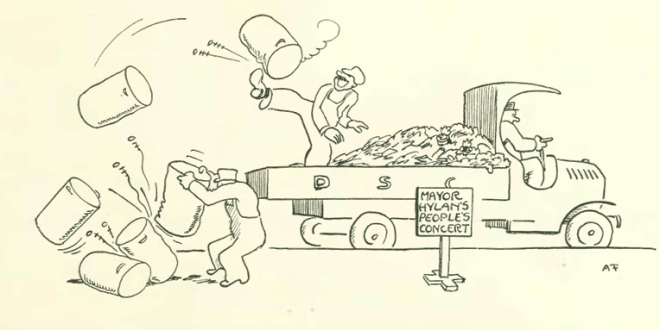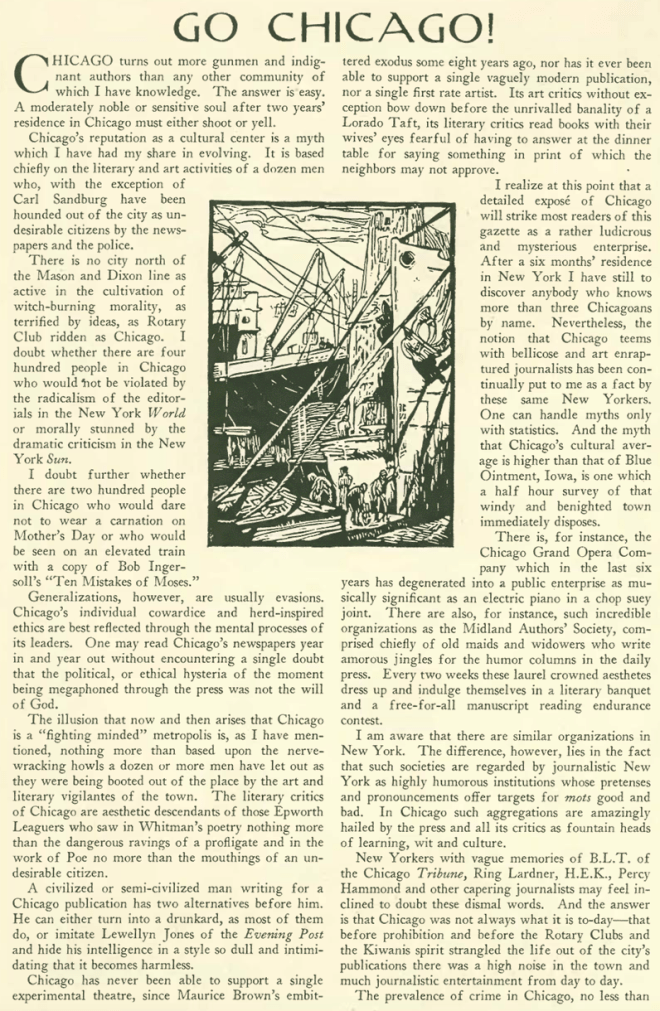The New Yorker rarely missed an opportunity to take potshots at rival cities such as Philadelphia or Boston, but Chicago was a special target in the magazine’s crosshairs as a notorious Midwestern backwater. The July 4, 1925 issue included a feature titled “Go Chicago,” in which Ben Hecht parodies the city’s pretensions and acts of boosterism.

Among Hecht’s observations:
There is no city north of the Mason and Dixon line as active in the cultivation of witch-burning morality, as terrified by ideas, as Rotary Club ridden as Chicago.
I include below the entire piece for the full effect of Ben’s acid-tipped pen:
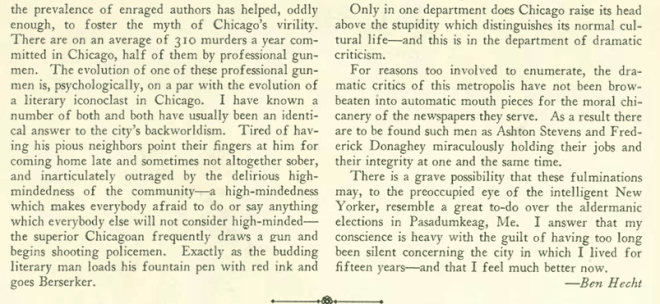
A note on Hecht: According to IMDB, he is considered one of Hollywood’s and Broadway’s greatest writers. He won an Oscar for best original story for Underworld (1927) at the first Academy Awards in 1929 and had a hand in the writing of many classic plays and films, including the play The Front Page and the film Notorious. Although he received no credit, Hecht was paid $10,000 by David O. Selznick to perform a “fast doctoring” on the script for Gone With The Wind.
The New Yorker celebrated its first Fourth of July with a busy, two-color cover depicting Coney Island’s famous Luna Park:

One wonders if the cover art was part of an arrangement for advertising revenue, given that this ad appeared on the back cover of the same issue:

The inside front cover of the issue featured a full-page ad for the Paramount film, Beggar on Horseback, complete with joke reviews from the “Old Lady in Dubuque” and others including the film’s two writers, Marc Connelly and George S. Kaufman, who were also advisory editors of The New Yorker:
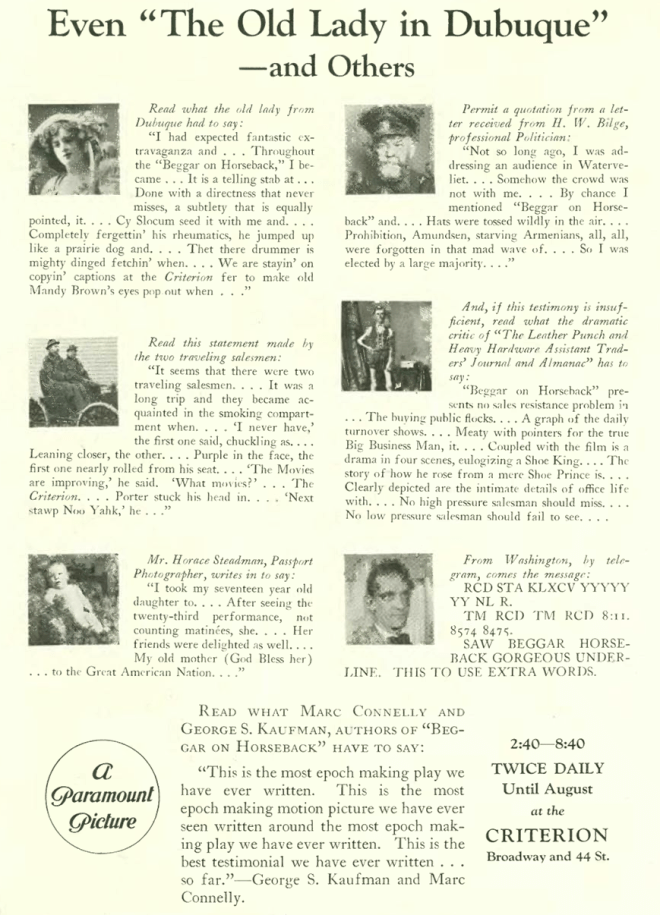
“Talk of the Town” commented on how modern artists such as Henri Matisse, Marsden Hartley, Charles Demuth and Constantin Brancusi were influencing contemporary fashion: “To-day sees the dress houses and even the Fifth Avenue department stores displaying “Cubist fashions”—scarves patterned like composite photographs of all the abstruse countenances in Euclid’s book of open curves, gowns that are marked with subtle diagrams on the variation of the triangle…sports blouses done in bands of gradated color and roundish forms which proclaim their nepotal relation to Cezanne…”
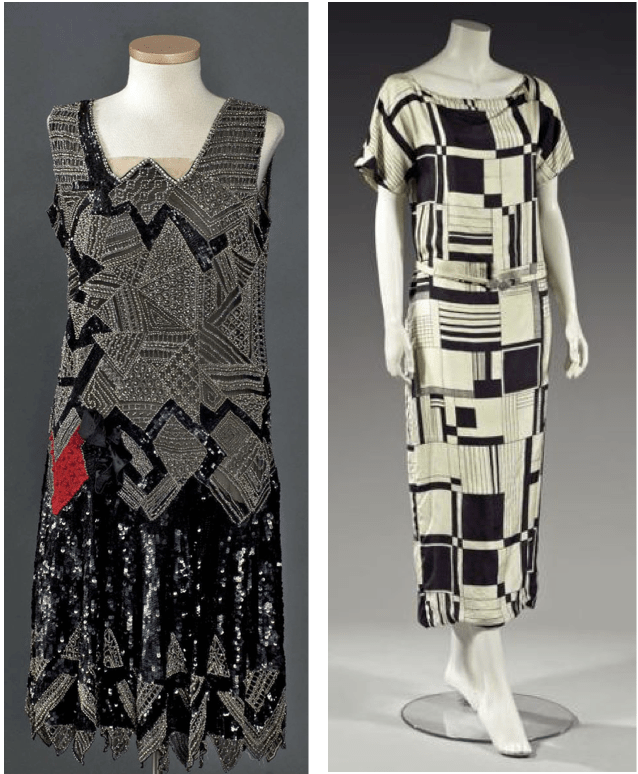
“Profiles” featured George Creel, an investigative journalist and politician who headed President Woodrow Wilson’s propaganda arm, the Committee on Public Information, during World War I. The profile’s author, Harvey O’Higgins, wrote that “The Incredible Mr. Creel” was often unpopular with the press as a war-time propagandist, but Creel himself was not a censor but rather a good-humored, honest man with “the ideals of an adolescent.”

In the “Of All Things” section, Howard Brubaker wryly observed: “Now that Dorothy Perkins has been sentenced to three years in prison we hope that ladies will think twice before killing gentlemen unless they are actually annoying.”
At the time, Perkins was the youngest woman ever charged with murder in New York. She was just 15 when she met 35-year-old Mickey Connors, described by blogger Mark Gribben in The Malefactor’s Register as a “truck driver and spouse-abusing divorced felon.”
Gribben writes that “Connors and Dorothy apparently met in June 1924 when he wed the mother of one of Dorothy’s girlfriends. After that marriage, Connors moved away from Greenwich Village, but kept in contact with Dorothy on the sly.”
According to Gribben, on Valentine’s Day 1925, a rival suitor for Dorothy, 26-year-old Tommy Templeton (who served with Dorothy’s father, Rudolph, in World War I), attended a birthday party for Rudolph at his Greenwich Village house. During the party, the drunken Rudolph apparently asked Dorothy, “Why do you want a bum like Connors when you can have a nice fellow like Tommy?” At some point Dorothy went to her room to fetch a .22-caliber revolver she had stolen from an aunt in Connecticut.

What ensued was related by the family minister, Rev. Truman A. Kilborne, in testimony to the court. Rev. Kilborne said the family told him that when Rudolph attempted to take the revolver from his daughter, she resisted and in the struggle the revolver went off. Templeton, who was standing nearby, was shot through the heart.
During her trial, Dorothy claimed that her standoffish treatment of Tommy (and being seen with Conners) was an attempt to make “(Tommy) jealous by flirting with someone else.”
On June 17, 1925, the jury rejected the state’s case that the shooting was murder and convicted Dorothy of manslaughter.
Contrary to The New Yorker account, Dorothy was sentenced to 5 to 15 years in the women’s prison at Auburn, but ended up serving just four years of the sentence, during which time she was trained as a stenographer. She was released in January 1929 for good behavior. Mickey Connors served a few months in the Tombs prison for contributing to the delinquency of a minor.
You can read Gribben’s full account in The Malefactor’s Register.
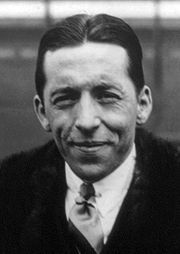
The issue also included this wonderful two-page illustrated feature by Ralph Barton, a subject in my previous blog post, The Vicious Circle. Barton was very familiar with French life and customs. According to Wikipedia, in 1915 Puck magazine “sent Barton to France to sketch scenes of World War I. It was then that Barton developed a great love of all things French, and throughout his life he would return to Paris to live for periods of time. In 1927 the French government awarded Barton the Legion of Honour.”

And finally, a cartoon from the issue that takes aim at New York City Mayor John F. Hylan. From the very first issue of The New Yorker (Feb. 21, 1925), the mayor (comically referred to as “Jonef Hylan”) was a frequent target:
The next great figure in the early legends of New York is that of Jonef Hylan. Hylan, in all probability, was not a real person; but it is impossible to understand New York without giving careful study to the Hylan myth. In many respects, it resembles the Sun Myth of other great civilizations; for his head was as a head of flame, and he rose early each morning from beyond the East River, bringing light into all the dark places and heat into the sessions of the Board of Estimate. The populace called their Sun God “Red Mike”; but in the frenzy of their devotions, they simply yelled “Ra! Ra!
